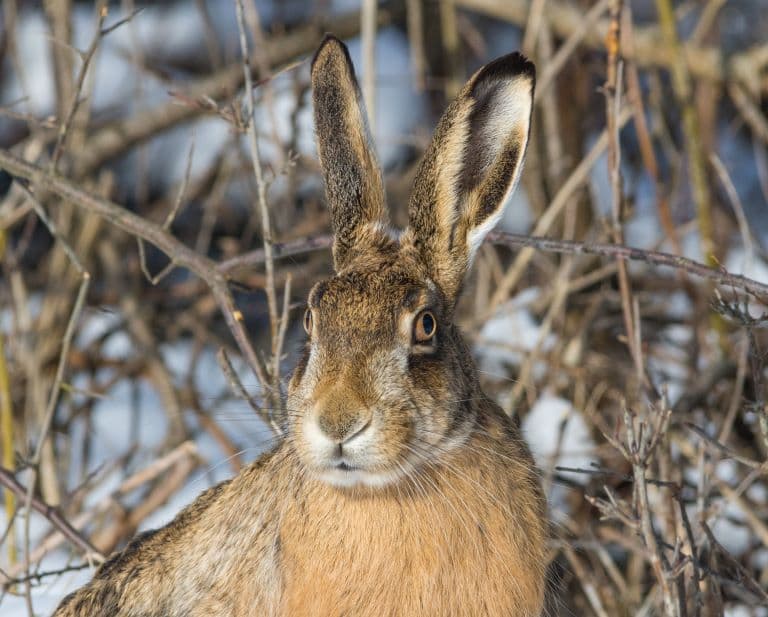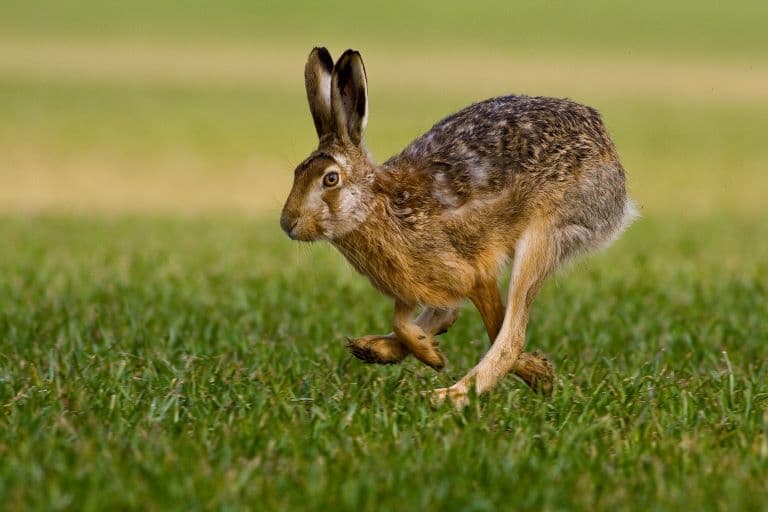European Hare Profile
It’s a shame that rabbits get so much attention. They’re small, aggressive, and not all that bright. But for some reason, their fluffiness makes them more popular than their powerful, charismatic and altogether remarkable cousins: the hares.
Okay, White Rabbit is a banger of a song, but it’s no coincidence that it was a hare, and not a rabbit, who became the most decorated warrior in the Toad Wars, or that a hare was the animal who could best match Michael Jackson in a dance-off in Moonwalker. Then, there’s Basil Stag, the eccentric freedom-fighting hare from the Redwall chronicles.
There’s no denying it: hares are cool, and they deserve recognition!

European Hare Facts Overview
| Habitat: | Shrubland, grassland |
| Location: | All over Europe, some Asia; introduced to Australia and South America |
| Lifespan: | 12 years |
| Size: | 60 to 75 cm (24 to 30 in) |
| Weight: | 4 and 7 kg (8.8 and 15.4 lb) |
| Colour: | Grey-brown |
| Diet: | Grasses and herbs, supplementing these with twigs, buds, bark and field crops |
| Predators: | Large foxes, dogs, large raptors |
| Top Speed: | Possibly up to 72km/h (45 mph) |
| No. of Species: | 1 |
| Conservation Status: | Least Concern (IUCN) |
The hare’s presence in our culture dates far beyond the Michael Jackson era. Hares have been a symbol of fertility since at least the Middle Ages, and have shown up in iconography for roughly as long as iconography has existed.
Hares are amazing, resilient creatures with a physical prowess that’s hard to beat, and this has served them well for most of their existence. The European hare is relatively healthy as a species, but their numbers are now dropping.
So, now is the time to pay attention to these outstanding lagomorphs, and help them retain their iconic position in human culture for millennia to come.
Interesting European Hare Facts
1. They’re Lagomorphs
Rabbits and hares are very rodent-like mammals, but they diverge from the rodent lineage right at the point of mammalian radiation after the dinosaur extinction, around 66 million years ago.
There are two families, one with the rabbits and hares, and the other with the pikas. All of these lagomorphs are abundant prey animals, and therefore incredibly significant contributors to the ecosystem, but of them all, the hare is the most resistant to being labelled a prey animal.
To say hares are hard to catch is an understatement. These animals are the outcome of an evolutionary arms race between predator and prey that has carved out one of the most exceptional athletes in the animal kingdom. 1

2. They have exceptional endurance
Hares are built to run. None of this bopping along with a fluffy bum that you see in rabbits; hares can move.
Their first line of defence is to sink down into a depression in the ground and hope not to be seen, which is adorable, but often naïve, as they’re the largest lagomorph and generally easy to spot. But if that doesn’t work, they have plenty more up their sleeve.
Their bones are specially adapted to withstand the stresses of extreme speed and immediate directional changes. Their noses are long, with wide nostrils for air intake and heating, and their ears are enormous radiators, helping to shed body heat during a sprint.
And a sprint it is, because when a hare is being chased, it accelerates at more than 4.4 m/s2, which is roughly 0-60 in 6.5 seconds. Its top speed is undetermined, but tentatively estimated to be around 72 km/h, and one of the fastest animals on land in Europe.
They can keep this pace for a lot longer than even a dog can, and their muscles are dark, thick and red with high endurance fibres. Their hearts are enormous to support these systems, but interestingly, they have smaller stomachs than a rabbit. 2
3. They’re picky eaters
This might reflect the nature of the hare’s diet, as it’s been established they are a lot more selective than rabbits when it comes to feeding.
Fat appears to be extremely important to European hares and they will pick out high-fat plants as well as select the parts of plants with the highest content of lipids. Interestingly, hares tend to avoid grains and cereals.
To reach their daily goals, hares need a diverse range of crops including wild weeds and grasses, and this is one of the ways conservationists are recommending that farmers help to protect the species. 3 4

4. Domestic violence is part of hare life
Hares are more solitary than rabbits, and spend less time out in the day. But during the Spring, they are far more active in daylight and come together to mate.
This mating season is when you’re likely to see them batting at each other in boxing matches, and this was once thought to be a form of male competition, but it’s now becoming apparent that it’s part of the female hare’s test for a superior partner.
To be successful in mating, the male hare has to expect a bit of a beating. Females will hit the male if she isn’t ready, or if she is ready, but not sure if he’s up to the task. The male will also be tested for endurance, being led into a chase by the female to make sure his stamina is good enough.
Sometimes this will be a Thunderdome-type deal, where the female will initiate with multiple makes, and only mate with the one who’s left at the end. Successful mating will result in some adorable hare babies, which will take shelter in a depression in the ground until they’re ready to go out. 5

5. They’ve been abused
While the species is listed as of least concern by the IUCN, populations of hares are in trouble. Traditionally, their physical prowess has made them a target for blood sports, in which dogs are set on the hares to test their skills.
Hares are also shot in huge numbers all across Europe, and they’re one of the most significant game animals in this context. Even licenced hunting of hares is cause for concern in some places and is criticised as being far too prevalent. Around 1000 hare shooting licences were given out per year from 2012 to 2019 in Scotland.
In 2018, licences were given out to kill 1308 hares between February and September.
But growing agricultural destruction threatens them even more. As farmland expands over its range, viable habitats are reducing, and while the species as a whole is widespread, various populations are becoming more fragmented and threatened. 6
6. They’re being forgotten
This destruction represents a ‘forgetting’ of the wildlife that Europe once revered. The hare has had a strong presence in European culture since European culture was invented.
It’s traditionally a symbol of fertility and courtship and has been since at least Ancient Greece. It’s been a well-deserved bane to the Christian church as a symbol of homosexuality and lustfulness for some reason, despite being described in Proverbs as “wiser than the wisest”.
Their mating season shenanigans gave us the phrase “As mad as a March hare”, which led to the conception of the Lewis Caroll character. The hare shows up again in Aesop’s fable and the Legend of Achilles and is depicted in countless paintings from the dawn of paintings, as a reminder of their presence when we were all growing up together.
Forgetting all of this has led us away from our natural world, and allows us to continue our rampant destruction of the ecosystems that raised us, both to the detriment of the animals we’ve forgotten and of ourselves.
7. They’re in decline
In optimal conditions, the European hare can exist in densities of up to 275 animals per 100 hectares. More commonly, they’re happy in densities as low as 2/100 ha, and we are seeing a widespread decline in both population and densities across their ranges.
Hare utopias are highly elevated, have annual snow of around one to two months, get about 500mm of rain per year and 2000 hours of sunlight. They like temperatures of above 10 ˚C on average and plenty of forage. This once described much of Europe, but with warmer, wetter Winters and more extreme weather conditions, things are changing.
8. Agriculture is the biggest problem
Climate change is of course to blame for the huge fluctuations in weather, but agriculture expansion is the biggest threat to hare populations.
While the conditions listed above are optimal for hares, they’re not too fussy and as tough animals will thrive in a wide range of conditions, if slightly less so than in optimal ones.
But with the expansion of agriculture, especially animal agriculture, they aren’t being given the space to thrive, and without concentrated efforts to maintain their habitats, we’re likely to see the urgency of this species’ conservation ranking bumped up in the coming years.
European Hare Fact-File Summary
Scientific Classification
| Kingdom: | Animalia |
| Phylum: | Chordata |
| Class: | Mammalia |
| Order: | Lagomorpha |
| Family: | Leporidae |
| Genus: | Lepus |
| Species: | Europaeus |
Fact Sources & References
- “Lagomorpha”, Science Direct.
- “European Hare”, iNaturalist.
- S. Williams (2008), “The mechanics of acceleration and deceleration in a habitual prey animal, the European hare”, Sci Hub.
- Stéphanie C. Schai-Braun (2015), “The European Hare (Lepus europaeus): A Picky Herbivore Searching for Plant Parts Rich in Fat”, NIH.
- The Independent (2021), “Video captures pair of hares standing up on hind legs and fighting”, YouTube.
- (2019), “Licensed to kill: the landowners who shoot thousands of brown hares”, The Ferret.
